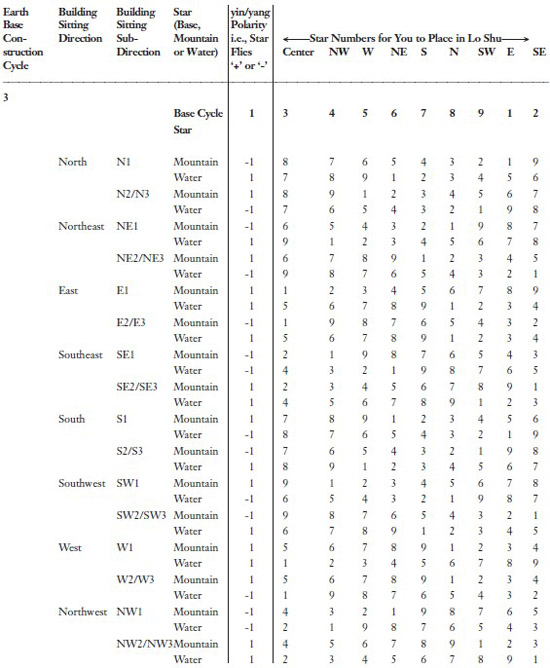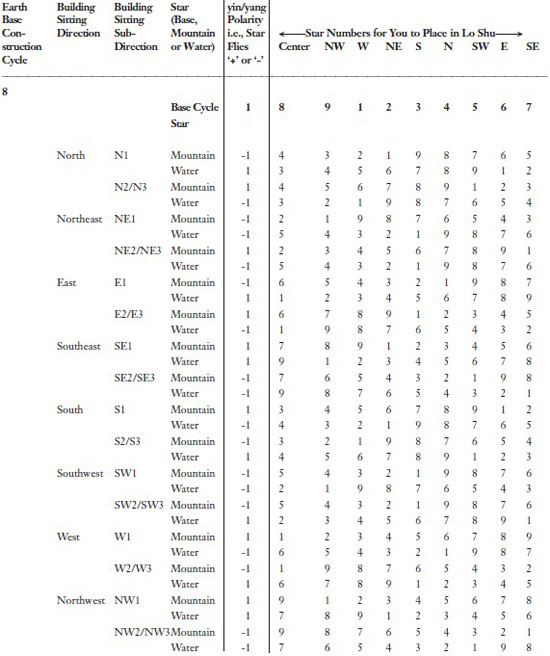There are also Water forms that correspond to each of the 9 Flying Stars. One set of correspondences between the Flying Star and Water configurations give a hint as to how the relevant Water feature should be supplied with Water. There is also an interesting correspondence with parts of the human body (which seems to be listed simply as a way of remembering the possible Water flow than for any other reason).
Table A10: The Nine Flying Stars with Their Corresponding Water Feature Flow Directions
| Star | Chinese
Name Shape | Meaning | Body part | Water flow |
|
| 1-White | T'an lang | Covetous Wolf | mouth | water can enter but not exit |
| 2-Black | Chu men | Great Door/
Gate | nose | water can enter and also exit |
| 3-Green | Lu ts'un | Rank (Salary)
Preserved | penis | water can exit but not enter |
| 4-Jade | Wen ch'u | Civil Career
("Windings") | ear | water may not enter or exit |
| 5-Yellow | Lien chien | Honesty, Purity,
Uprightness | eyes | water can exit but not enter |
| 6-White | Wu ch'u | Military Career
("Windings") | navel/belly | water can enter but not exit |
| 7-Red | P'o chun | Broken Army | anus | water can exit but not enter |
| 8-White | Tso fu | Left Assistant | nose | water can enter and also exit |
| 9-Purple | Yu pi | Right Assistant | navel/belly | water can enter but not exit |
We wont go into great detail, but the above table gives some hints as to how to engineer Water features to support these Stars where they arrive in the form of Water Stars. Of course you should only support the Star if it were auspicious and advantageous.
Appendix 11
Feng Shui Practice
When you come to using your skills with Flying Star feng shui, the first thing you need to buy is some kind of practice book. It could be loose leaf with photocopied sheets or a large format lined notebook, whichever suits you. The thing you must avoid is doing various feng shui diagnoses on sundry bits of paper that may soon get lost. Keep it all in one book where you can refer back to it, to see what you found in the past, and to check on results in a years time. This way you can be sure what worked and what didnt.
Initially you should just do your own Flying Star feng shui, then that of friends, resisting the temptation to prescribe cures or remedies until you have had enough practice to be confident and fluent in drawing up correct charts. Then you need to do a few feng shui changes and watch and record the results. That kind of experimentation is invaluable, but it is not kind to do it at the expense of strangers. You should be ready to say when you are wrong or when it does not appear to have worked. You can only learn by your mistakes. Many of you will not want to go beyond working on your own feng shui and perhaps doing an occasional reading for immediate friends.
But if you do go beyond this and actually do consultations, then at this point you have an ethical dilemma. You are not trained sufficiently to practice professionally, but on the other hand you dont want to spend hours of your time working without recompense. I suggest the way round that is to suggest a donation in proportion to the perceived benefits of any formal reading that recommends remedies or a course of action. Certainly this will result in a few no fees, but on the other hand you will get some measure of client satisfaction. When you have started to have noticeable success, and perhaps spent some time doing charts with an acknowledged teacher or Master, then and only then, should you think of a fee scale.
Appendix 12
Typical Analysis Sequence
It is helpful initially to have a checklist of the order in which to do things. The checklist below is not exhaustive, merely a suggested way of working.
You need an accurate ground plan of the building you are working on, a blank Lo Shu, and a lo pan.
1. Record details of:
Date of reading/consultation Name of owner
Address
Date and time of owners birth
Date of construction of building
Date of present owners move in
2. From this you should be able to calculate:
Construction Period (Period Star or Earth Base) of building
Period Star of present owners move in date (if required)
Personal Star (kua number) of the owner and from this the owners 4 best/worst directions, sheng chi, etc.
3. Use your lo pan to determine and write down the buildings
Facing Mountain direction (and exact degrees)
Sitting Mountain direction (and exact degrees)
(which should be 180 degrees greater/lesser than the Facing direction)
4. Draw up the chart with Period, Mountain, and Water Stars.
Mark in the Period Star (construction or move in Period) in the central Palace.


























